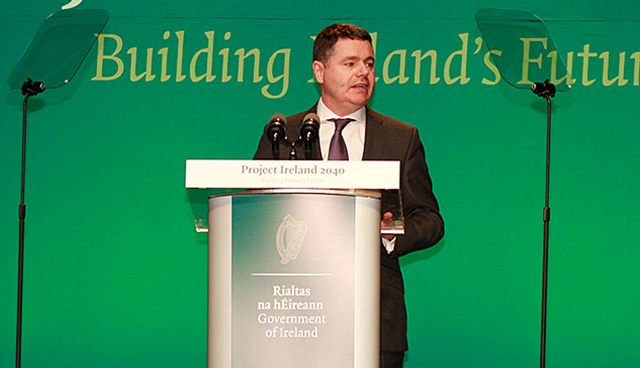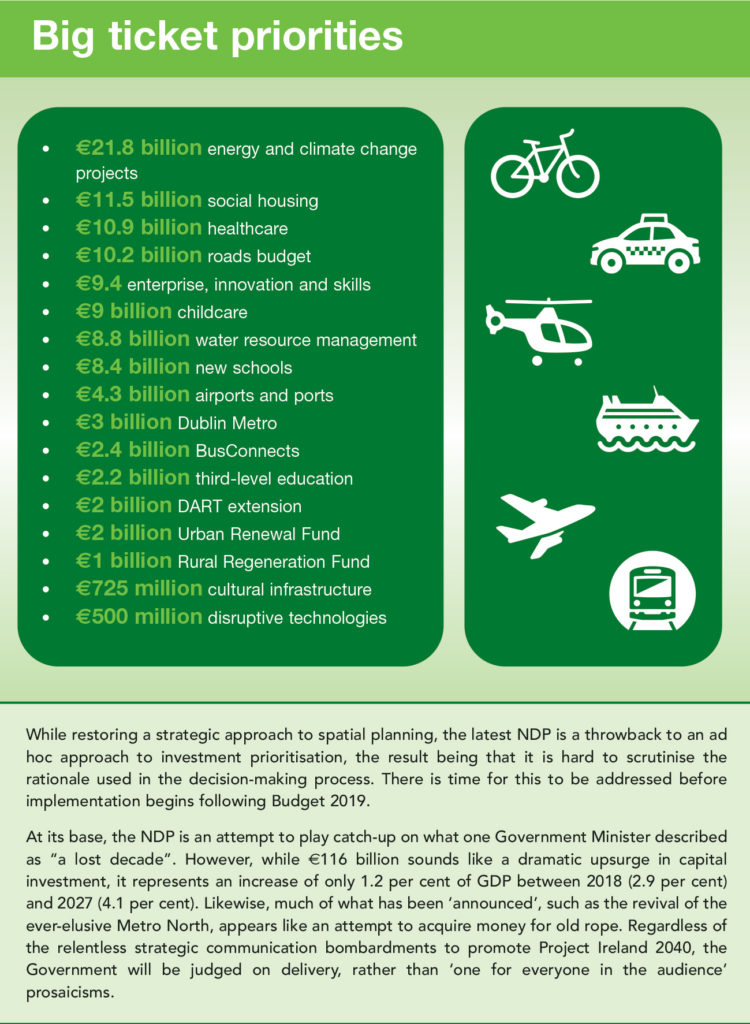The National Development Plan in brief


Published in February, the 10-year National Development Plan is the latest Government public capital investment plan. Together, with the National Planning Framework, it forms a crucial component of the Government’s Project Ireland 2040. eolas attended the Sligo launch.
In the aftermath of the 2008 economic collapse, Ireland’s public infrastructure spending was severely curtailed. The 2007-2013 predecessor to the current capital plan was abandoned by 2008 and forward planning obstructed by funding uncertainties. Indeed, in the aftermath of the crash, capital investment was slashed to 2.5 per cent of GDP.
The result is an existing infrastructural deficit which is failing to keep step with the country’s current rapid growth, with the potential to hinder efforts to achieve optimal potential in terms of economic competitiveness and performance into the future. Quality spatial planning is regarded as being at the crux of ensuring that Ireland can meet its growth potential in a way which is sustainable.
By 2040, it is anticipated that Ireland will approach pre-Famine population levels of 8 million across the island. In the intervening period, an additional 660,000 employment opportunities will be required. Now, the economic headwind of Brexit and the challenge of supporting the growth of the knowledge economy combine to necessitate a strategic approach to public capital investment.
The stated aim of the National Development Plan (NDP) 2018-2027 is to act as a driver for “Ireland’s long-term economic, environmental and social progress across all parts of the country over the next decade”. The NDP outlines multi-annual funding for the transport, health, education and energy sectors.
The NDP is intended to act as the investment plan which will underpin and ensure the success of the National Planning Framework. Major challenges facing the successful realisation of the NPF include demographic change; the need to move to a low-carbon economy; Brexit; and ensuring sustainable economic growth through the opportunities afforded by a significantly enlarged population.
Project Ireland 2040 is different, it is asserted, because planning objectives are supported by investment priorities, meaning proactive rather than reactive intervention, in an attempt to rebalance national planning and counter the gravitational pull of regions of socio-economic advantage.
To support the NPF’s 10 National Strategic Outcomes, the NDP contains corresponding Strategic Investment Priorities. The Strategic Investment Priorities and their corresponding NSOs are as follows:
1. housing and sustainable urban development (compact growth);
2. national road network (enhanced regional accessibility);
3. rural development (strengthened economies and communities);
4. environmentally sustainable public transport (sustainable mobility);
5. enterprise, skills and innovation capacity (a strong economy);
6. airports and ports (high-quality international connectivity);
7. culture, heritage and sport (enhanced amenity and heritage);
8. climate action (transition to low-carbon and climate-resilience);
9. water infrastructure (sustainable waste and water management); and
10. education, health and childcare (access to quality).
By interweaving the NPF and the NDP, the Government aims to make decisive shift away from a separation which contributed to the failure of previous plans, the subsequent urban sprawl and associated failings in the housing market, excessive congestion and lethargic progress in meeting climate change objectives.
The NDP identifies lessons from previous public investment plans, including:
• a need to prioritise areas for public investment in correlation to the economy’s requirement for long-term growth, development and sustainability;
• a need to ensure the attainment of value-for-money; and
• a need to secure affordability and minimise risk of overheating in the economy.
This “significant level of investment”, totalling almost €116 billion (including €91 billion of Exchequer funding) is supplemented with €25 billion of investment from State-owned enterprises.
Through investment in public infrastructure priorities such as high-speed broadband, public transport and the delivery of “better communities”, it is intended that Ireland’s national competitiveness will be strengthened.
The NDP also outlines an overhaul of the process by which capital investment is planned and delivered. This, the plan states, “will be achieved through a decisive shift to integrated regional investment plans, stronger co-ordination of sectoral strategies and more rigorous selection and appraisal of projects to secure value for money”.
Resource allocation for projects which support the priorities of the NPF is to be guided by a new funding model for Exchequer-funded public investment. To this end, four new funds, totalling a combined €4 billion between 2018 and 2027, will be allocated through a competitive bidding process, designed to encourage collaboration. Here it is suggested that, where appropriate, additional private investment will be leveraged. Project proposals should demonstrate a vision in line with NPF objectives, including rural renewal, urban regeneration and climate action targets, while drawing on disruptive technologies.

Under the NPF and the NDP, a new National Regeneration and Development Agency will be established to work closely with central government, local government and semi-state bodies to identify publicly-owned land which have potential for repurposing. The stated objective here is to ensure that underutilised landbanks in urban settings are used to their maximum potential.
Through this, the NDP is aimed at supporting the rebalancing of:
• Ireland’s three regions (the Northern and Western Region, the Southern Region and the Eastern and Midland Region);
• the main cities (Dublin, Cork, Limerick, Galway and Waterford);
• urban centres (including Sligo and Athlone, Letterkenny as a component of the North-West Gateway Initiative and Drogheda-Dundalk as part of the Dublin-Belfast Economic Corridor);
• towns and villages (in which 37 per cent of the population live); and
• the North-West (in the context of Brexit).
However, while the Late Late-esque regional balance is to be welcomed, the plan is not without flaw. One criticism of the latest NDP is that while the majority of its predecessors were required, as a condition of EU funding, to provide evidence for prioritisation decisions, it does not.
In other words, the 2018 plan fails to utilise evidence-based processes to demonstrate that priority investments will yield the optimal socio-economic and environmental return. Previously, a review process was also incorporated to ensure that decisions could be revised, thereby ensuring value for money. Such a process also meant that, in spite of changing political tides, prioritisation remained in place as per the evidence and, overall, the capital investment plan remained relatively stable regardless of which party was in office.





